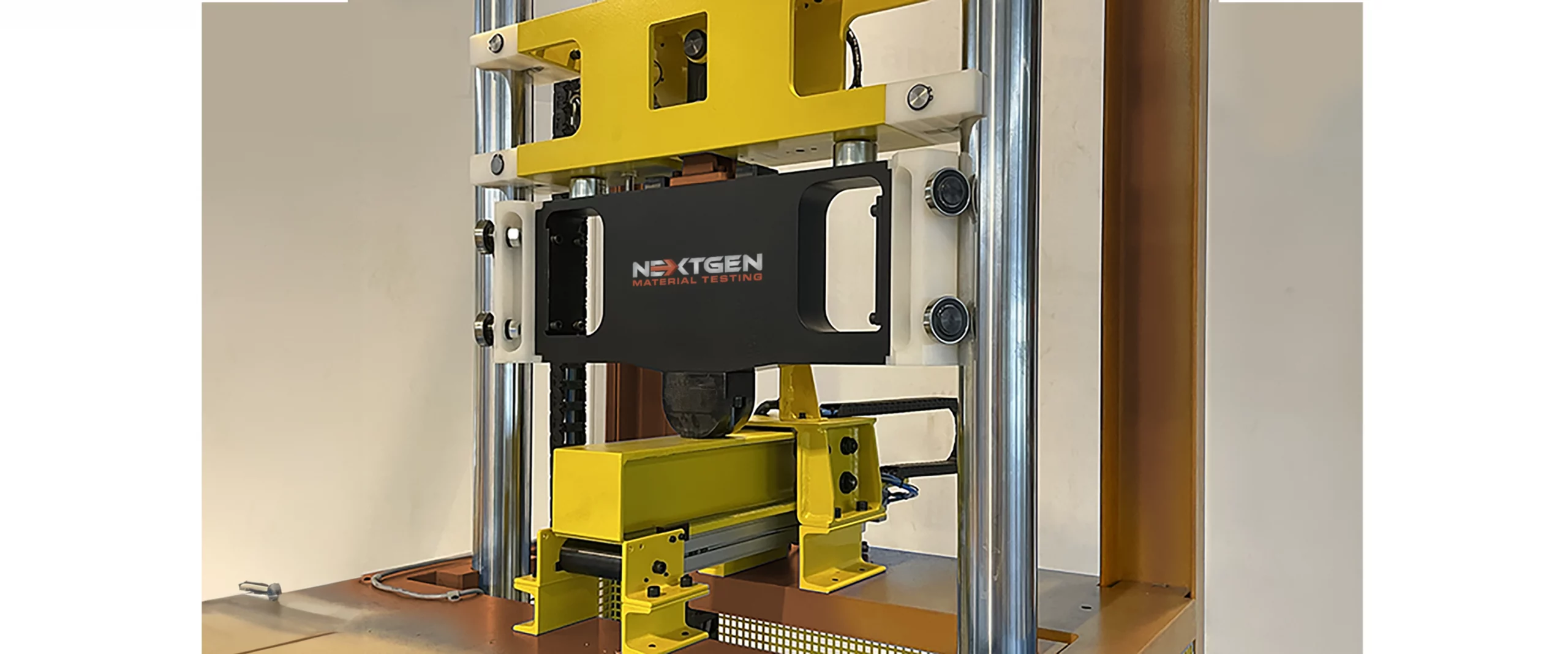Safety advice is found everywhere—from using electronics to taking the elevator, it’s part of daily routines. When people think of safety measures, the image of a hard hat often appears first. However, not every hard object worn on the head offers real protection. So, how do we know which helmets, materials, or products are really safe and dependable in dangerous situations? Drop weight testing is one of the most important answers.
Drop weight testing measures how materials or products respond to sudden impacts. It involves dropping a known weight from a certain height onto a sample to see how it reacts, like whether it breaks, bends, absorbs the shock, or survives the hit. Engineers can use this testing method to find out how strong, tough, and likely to fail a material is. Many fields use it, such as for pipeline safety, packaging, electronics, aerospace, and car design. There are many different types of drop weight testing, depending on the material and the goal. For example, you can test thin plastic films, big steel plates, or even whole products.
If you want to learn more about drop weight testing — how it works, its history, what it measures, and where it is used — this article is for you.
What is Drop Weight Testing?
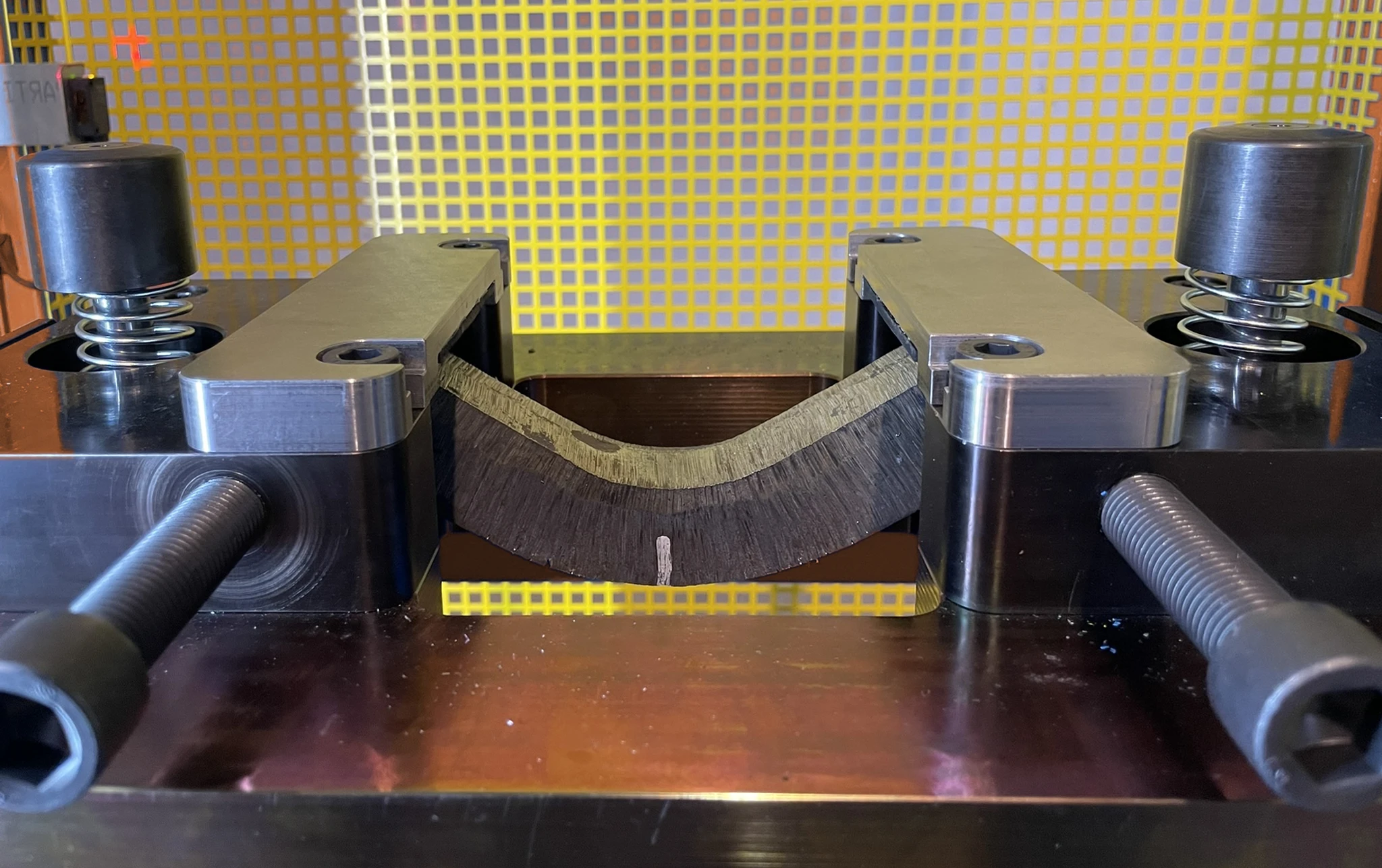 Drop weight testing is a controlled method used to measure how a material or product behaves under a sudden, high-speed impact. It involves raising a known weight to a specific height and then allowing it to fall freely onto a prepared specimen. The goal is to mimic shock conditions in the real world and see how well the tested item can absorb energy, avoid breaking, or stay intact. Engineers and manufacturers can use this testing method to find out important performance characteristics like impact strength, fracture toughness, crack arrest capability, and overall durability.
Drop weight testing is a controlled method used to measure how a material or product behaves under a sudden, high-speed impact. It involves raising a known weight to a specific height and then allowing it to fall freely onto a prepared specimen. The goal is to mimic shock conditions in the real world and see how well the tested item can absorb energy, avoid breaking, or stay intact. Engineers and manufacturers can use this testing method to find out important performance characteristics like impact strength, fracture toughness, crack arrest capability, and overall durability.
There is a simple physical principle behind the test procedure. When the weight falls, its potential energy turns into kinetic energy. At the moment of impact, this energy is transferred to the specimen. The formula E = mgh, where m is mass, g is gravity, and h is drop height, is used to figure out how much energy is delivered. Modern drop weight testers use guided rails or drop towers to make sure the striker hits the sample exactly where it should. Some more advanced systems also use sensors, accelerometers, or high-speed data collection tools to measure force, speed, deformation, and energy absorption in real time.
Before testing, the samples are cut or shaped to fit the size requirements of the relevant standard. For metals and composites, they may also be conditioned to certain temperatures to mimic the conditions of service, like cold weather. In some cases, the specimen is not just a sample of raw material but the actual finished product or assembled component. After preparation, the specimen is placed on a suitable fixture, and the weight is released. Once the impact occurs, the results can be evaluated by checking whether the specimen broke, dented, cracked, or remained intact. In many cases, the outcome is supported by both visual inspection and measured data, such as energy absorption or force at failure.
Historical Development
Drop weight testing began in the early 1950s with the development of the Pellini test at the U.S. Naval Research Laboratory. This method was made to stop brittle fractures in welded ship structures. It also showed how to find the nil-ductility transition temperature (NDTT) of steels, which is the lowest temperature at which a material acts in a ductile way. It became very popular and was later made into the standard ASTM E208. Battelle Memorial Institute developed the Drop-Weight Tear Test (DWTT) in the 1960s to fix the problems with the Pellini method when it came to pipelines. By measuring the fracture surface to find the percentage of ductile versus brittle failure, DWTT gave more detailed information and became standard through ASTM E436 and API RP 5L3.
As material technologies evolved, drop weight testing expanded beyond metals. Instrumented drop towers made it possible to get exact impact measurements for plastics and composites. This led to standards like ISO 6603-2 for plastic puncture and ASTM D7136 for composite structures. At the same time, drop tests on products and packaging became necessary for making sure that consumer electronics, medical devices, and freight systems were of good quality. Drop weight testing has become a versatile and important tool in many fields thanks to ongoing improvements like high-speed data capture, programmable impact settings, and environmental conditioning.
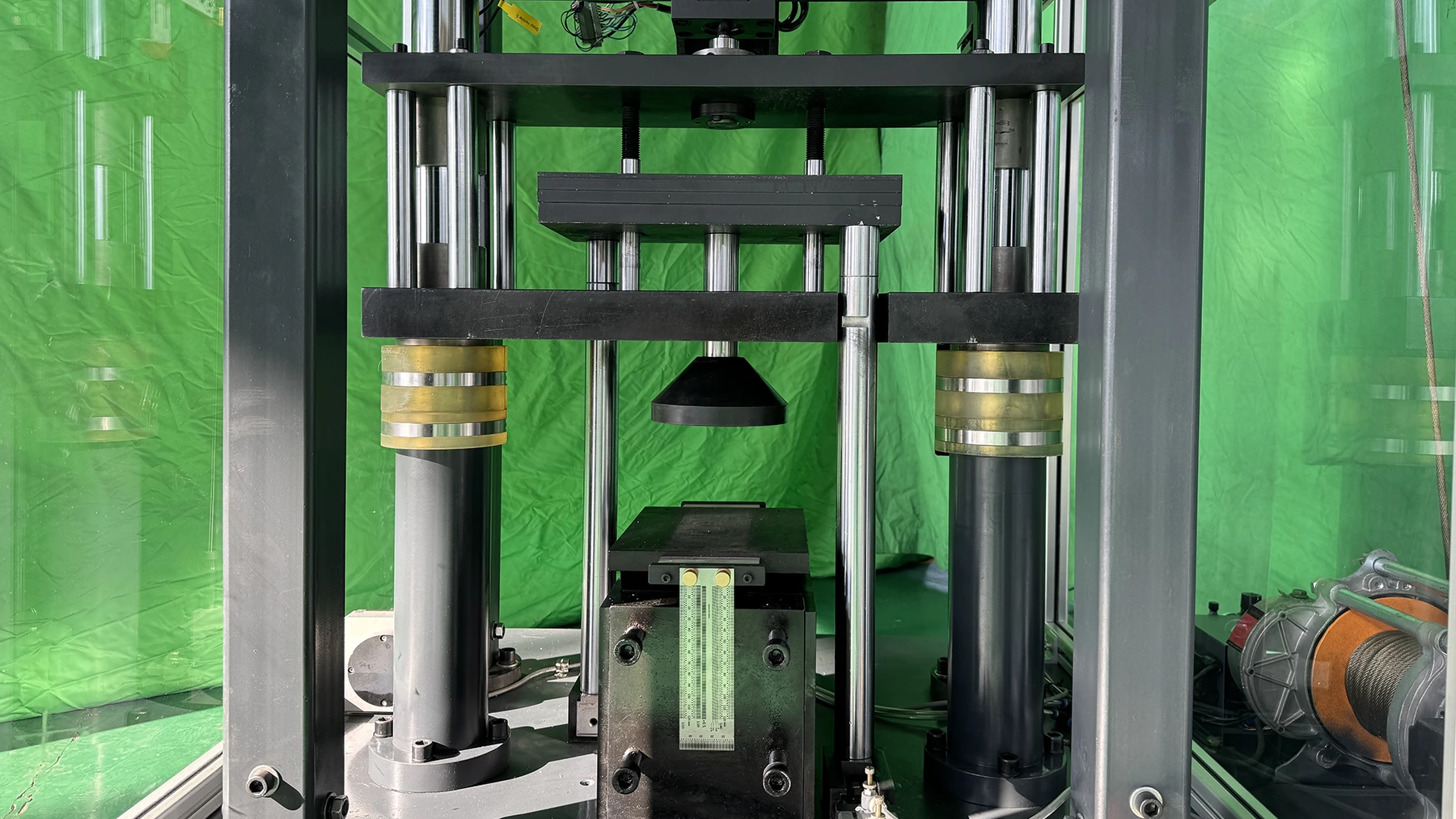
Types of Drop Weight Tests and Variations
There are many methods available to do drop weight testing, but they all follow the same basic idea: using a falling mass to imitate impacts in the real world. But the use, type of specimen, and method of evaluation can be very different. There are three main types of these differences: material-level tests, product/package-level tests, and specialized setups.
Drop Weight Impact Tests for Materials
These tests are mainly used to see how well raw materials like metals, plastics, composites, and coatings can handle impacts. Some of the most common examples are:
- Pellini Drop-Weight Test (ASTM E208): This test is used to determine the nil-ductility transition temperature of steels, identifying the point at which the material transitions from ductile to brittle behavior. A rectangular notched specimen is struck in a three-point bending setup. If a brittle fracture occurs, the temperature is too low for safe application. This test is widely used for pressure vessel steels, shipbuilding plates, and structural components.
- Drop-Weight Tear Test (DWTT – ASTM E436 / API RP 5L3): Commonly used for pipeline steels, DWTT evaluates the fracture surface after impact. A full-thickness, notched strip is impacted using a drop weight, and the resulting surface is analyzed for the percentage of ductile shear versus brittle cleavage. This data helps define ductile-to-brittle transition curves for safe use in cold environments.
- Plastics – Falling Dart and Puncture Tests (ISO 6603-2 / ASTM D3763): Rigid plastic plates are tested using a hemispherical striker dropped onto clamped samples. For thin films, standards like ISO 7765 and ASTM D1709 use free-falling darts to determine failure thresholds. These tests measure energy absorption and puncture resistance, especially important for packaging materials and industrial films.
- Composites – Drop Impact and CAI (ASTM D7136 / ISO 18352): Composite panels, such as carbon or glass fiber laminates, are impacted to simulate real-life damage (e.g. tool drops, hail). The damaged sample is then tested for Compression After Impact (CAI) strength to assess remaining structural integrity. These tests are essential in aerospace and automotive development.
- Coatings – Gardner Impact Test (ASTM D2794 / ISO 6272): Used to assess the adhesion and toughness of paints or coatings, this test involves dropping a small, rounded weight onto a coated metal panel to detect cracking or disbonding. It is widely used in quality control for painted or coated products.
Product and Packaging Drop Tests
These tests inspect how well real products or packaged goods work when they are handled or dropped by accident. The focus here is on how well something works, how safe it is, and how to keep it from getting damaged.
- Consumer Electronics and Devices: Smartphones, laptops, and handheld electronics are commonly drop-tested from typical use heights (3–6 feet). The device may be dropped on various sides — corners, edges, or faces — to simulate real-world impacts. Some systems use rotating drum drop testers to simulate repeated drops from random orientations.
- Packaging and Freight Containers: Standards like ASTM D5276, ISO 2248, and ISTA 3A define procedures for dropping packages from specified heights based on weight. These tests check whether the product inside remains intact and functional. They are essential in industries such as e-commerce, logistics, and pharmaceuticals.
- Automotive and Aerospace Components: Larger assemblies such as fuel tanks, battery housings, or instrument panels may undergo drop tests to assess crash resistance.
Specialized Drop Weight Setups
Some testing situations call for drop weight setups that are not standard or that have been made to fit certain engineering or research needs.
- Dynamic Fracture and Crack Arrest Testing: These setups assess how cracks initiate or stop under impact. For example, a heavy striker may be used to test crack propagation in full-thickness steel plates.
- Explosive and Bulge Tests (Historical): Prior to standardized drop weight testing, explosive bulge tests were used to assess steel toughness.
- Geotechnical Impact Tests: In civil engineering, drop weights are used to evaluate soil or pavement response to impact (e.g. California Bearing Ratio shock loading). While not material testing in the classic sense, the physics is similar.
In short, the way drop weight tests are done depends on the type of specimen, the test’s goal, and the real-life situations they are meant to imitate. Each test is based on a controlled, gravity-driven impact that shows how a product or material behaves when something goes wrong.
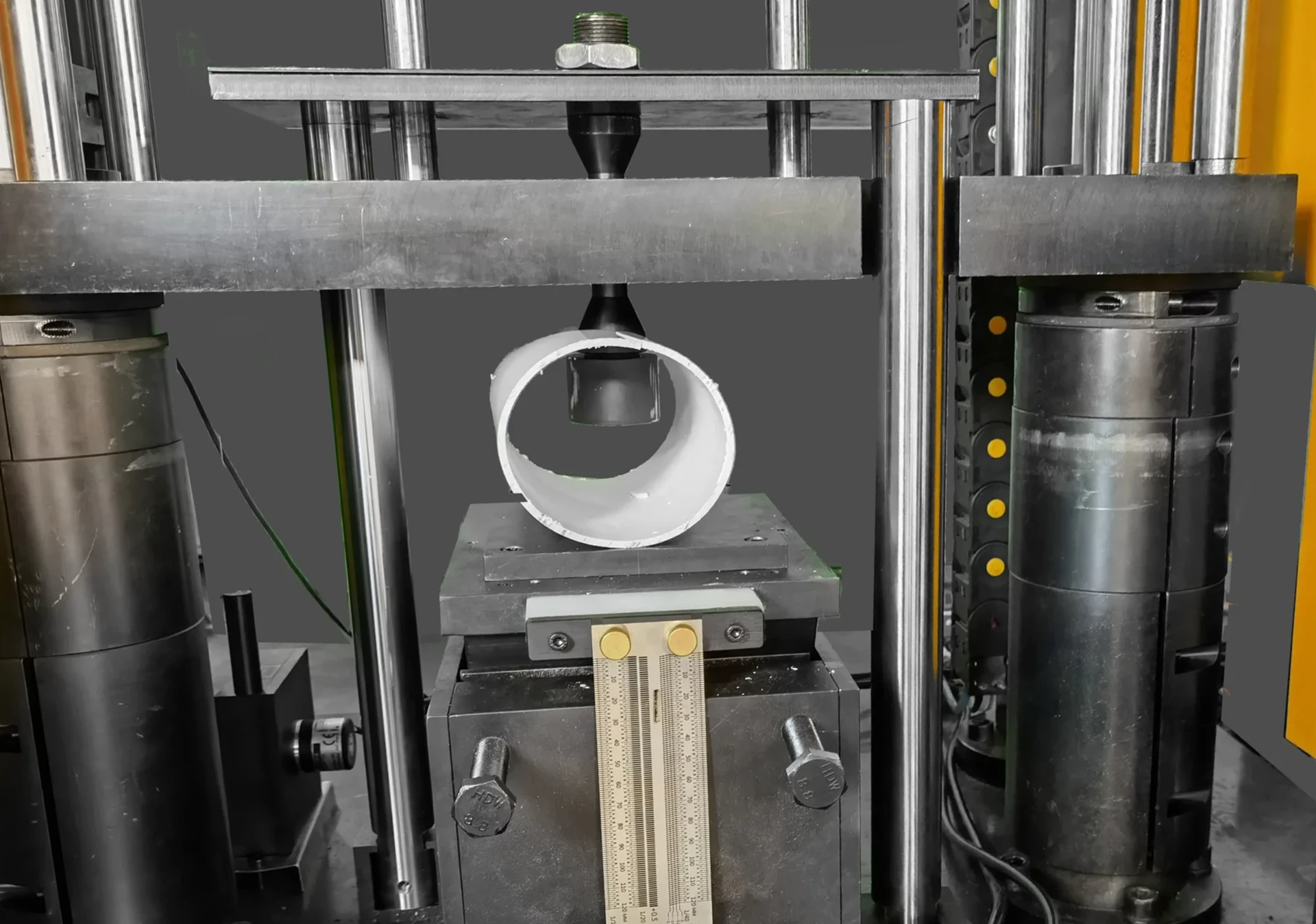
What Drop Weight Testing Can Tell Us: Key Measurements and Results
Let us take a closer look at the useful information and insights that drop weight testing gives us. These tests can yield both basic pass/fail outcomes and detailed performance metrics for the materials, depending on the equipment and standard used. Below are the key types of data commonly gathered during drop weight testing:
Impact Energy Absorbed
The quantity of energy that a specimen absorbs during impact is one of the primary outcomes. This can be determined by either the loss of kinetic energy or, more precisely, by using load-displacement data in instrumented systems. For instance, if a drop weight begins with 1000 J of potential energy and rebounds with 200 J, the specimen has absorbed 800 J. This is often reported as energy per unit area or thickness in plastics testing.
Break/No-Break and Failure Thresholds
Certain tests, such as the Pellini method, are binary in nature: either the sample breaks or it does not. These pass/fail results are instrumental in identifying critical temperatures or loading conditions. The objective of packaging and film testing may be to determine the drop height or weight that results in failure in 50% of the specimens, thereby establishing a failure threshold.
Fracture Appearance and Mode
The fracture surface of metals provides a wealth of information regarding the material’s failure. A brittle fracture is smooth and shiny, whereas a ductile fracture has a fibrous, rough texture. A transition curve is generated by tests such as DWTT, which quantify this as a percentage of ductile (shear) versus brittle (cleavage) area, thereby showing the change of fracture behavior as temperature increases.
Force, Time, and Deformation Data
Instrumented drop towers record force-time or force-displacement data. From these curves, engineers can extract:
- Peak force at impact
- Total energy to break
- Time to failure
- Amount of deformation
Failure Mode Observation
Visual inspection continues to be important. Critical failure indicators include shattering, internal delamination, cracks, or dents (e.g., in composites). It helps in the identification of design weaknesses or safety issues that may not be adequately represented by numerical data.
What Equipment Is Used for Drop Weight Testing?
Depending on the application and the level of precision required for testing, drop weight testing equipment can range from basic manual devices to complex instrumented systems. The primary equipment types for drop weight impact testing are listed below:
Standard Drop Towers
A common drop weight tester consists of a vertical tower with guided rails, a weighted impactor, a specimen support fixture, and a release mechanism. The impactor often has interchangeable tips of varying shapes and sizes, such as flat or hemispherical ends, to meet specific material types and test objectives. The energy levels can be precisely controlled by adjusting the mass of the impactor and the drop height. In order to guarantee safety and repeatability, contemporary systems implement motorized lifts and controlled release mechanisms.
Energy Range and Test Capacity
Lower-energy testers are used for applications such as plastic films, packaging, or thin composites, providing impact energies ranging from a few Joules to several hundred. Larger systems are capable of applying tens or hundreds of kilojoules of energy through heavier weights or higher drop heights for heavy-duty testing, such as thick steel plates or structural parts. Reinforced floors or vibration-absorbing mounts can often be necessary for these high-capacity systems.
Instrumentation and Data Collection
Advanced drop towers are equipped with sensors such as load cells and accelerometers. This enables the precise calculation of absorbed energy, peak force, and material deformation during impact by capturing detailed force-time and displacement data at high sampling rates. Additionally, velocity gates or optical sensors may be implemented to confirm the precise drop velocity.
Versatile Fixtures and Environmental Options
The same tower can perform many kinds of tests, including puncture, flat impact, and three-point bending, due to the interchangeable fixtures. Environmental chambers are commonly used to subject specimens to specific temperatures prior to impact in temperature-sensitive tests, which are typically conducted for cold-weather material simulations.
Packaging and Component Drop Testers
Products or packaging are assessed using distinct drop testers. These consist of quick-release mechanisms or adjustable platforms that enable the descent of flat surfaces, corners, or edges. Certain testers are equipped with guided multi-angle mechanisms or rotating drum systems to simulate repeated impacts.
NextGen’s Approach to Advanced Drop Weight Testing Systems
At NextGen Material Testing, Inc., we know the constantly shifting requirements of product and material testing environments. That is why we provide industry-ready solutions that combine automation, precision, and compliance with global standards. Our drop weight impact testing equipment is engineered to satisfy the most stringent technical requirements, no matter whether you are testing metals, plastics, composites, or complete components. If you are in search of a system that is versatile and capable of performing both routine and specialized testing, we recommend that you examine our flagship models in greater detail:
DWT‑1800 Computer Controlled Drop Weight Impact Testing Machine
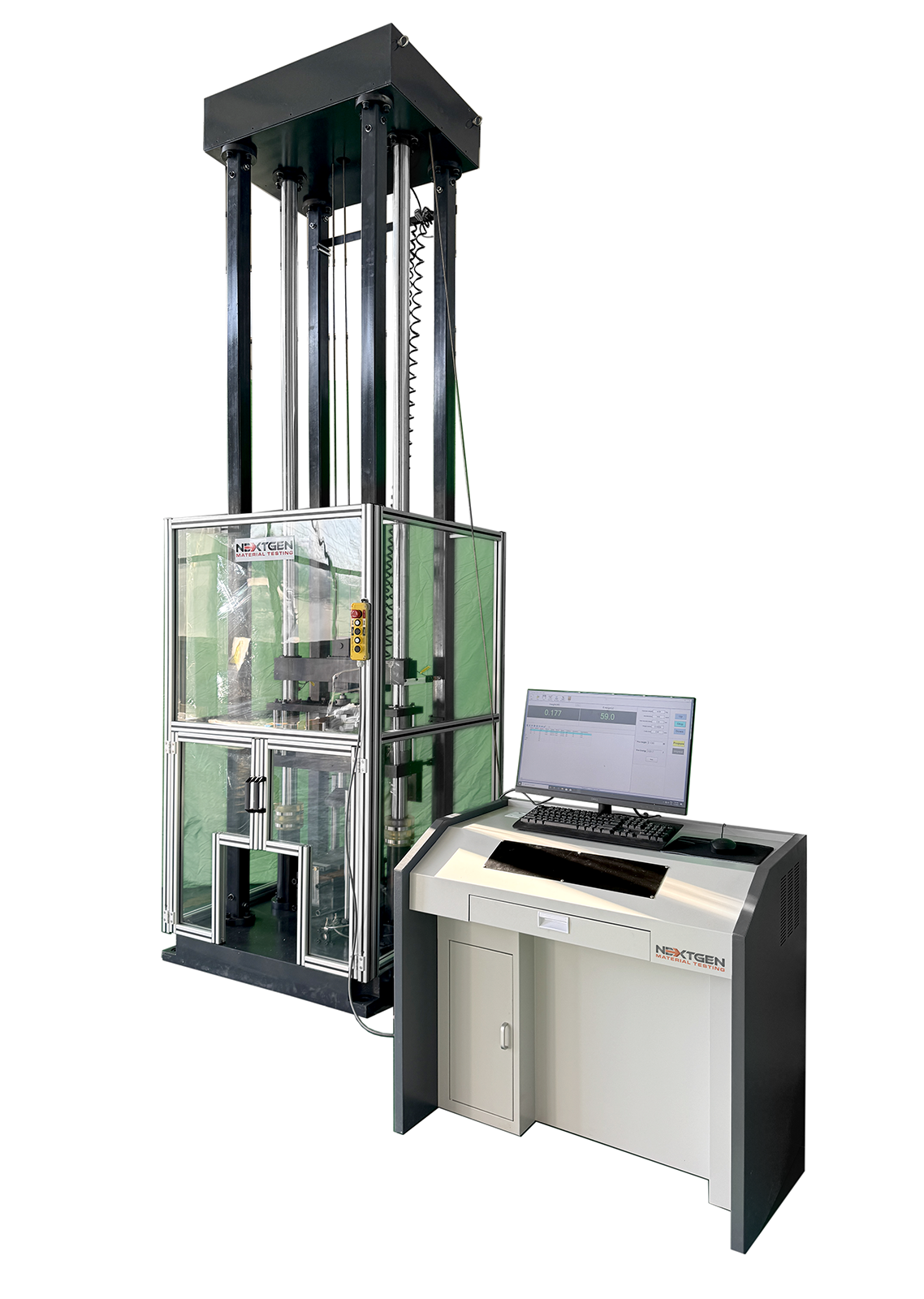 The DWT-1800 is a high-capacity, fully automated drop weight impact testing system that has been developed to assess the impact resistance of metals and rigid materials. This unit is capable of supporting both high-energy industrial tests and UL-compliant tests, with a capacity range that extends from 3.72 J to 1800 J. Its intuitive touchscreen interface enables users to easily regulate energy, hammer weight, and drop height with exceptional precision. The system is PLC-based. Precision and operator safety are both improved during testing by the implementation of critical safety features, such as anti-secondary impact protection and a secure enclosed zone.
The DWT-1800 is a high-capacity, fully automated drop weight impact testing system that has been developed to assess the impact resistance of metals and rigid materials. This unit is capable of supporting both high-energy industrial tests and UL-compliant tests, with a capacity range that extends from 3.72 J to 1800 J. Its intuitive touchscreen interface enables users to easily regulate energy, hammer weight, and drop height with exceptional precision. The system is PLC-based. Precision and operator safety are both improved during testing by the implementation of critical safety features, such as anti-secondary impact protection and a secure enclosed zone.
This device is optimal for the testing of ferritic steels, PVC conduits, cast and forged components, and a variety of enclosures in accordance with UL standards. It provides adaptability by means of automated height control, adjustable sample seating, and interchangeable hammers and anvils. The minimal maintenance and long-term performance are guaranteed by the robust steel frame and wire encoder system. Performance at scale is provided by the DWT-1800 for laboratories and industries that necessitate certified, high-accuracy impact data.
NG‑FWT1 & NG‑FWT2 – Low-Capacity Drop Weight Testers Up to 2000 J
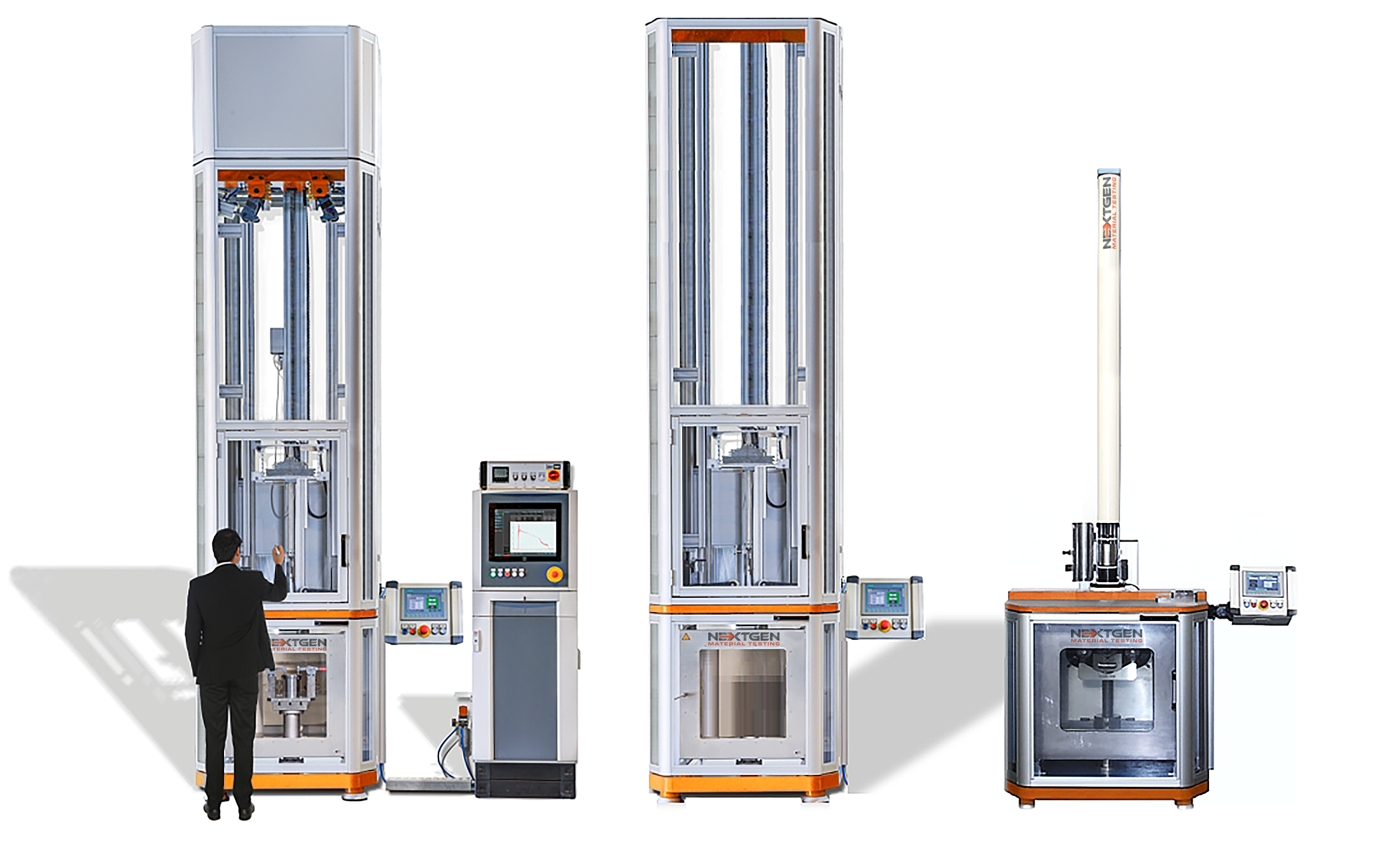 Next, our NG-FWT1 and NG-FWT2 systems offer a modern and adaptable method for conducting low- to medium-energy drop weight impact tests. These vertical testers are capable of analyzing a diverse array of materials, components, and product samples, with nominal capacities of up to 2000 J. Numerous international standards are supported by these systems, making them an optimal choice for regulated testing environments, R&D teams, and quality control labs in many different industries.
Next, our NG-FWT1 and NG-FWT2 systems offer a modern and adaptable method for conducting low- to medium-energy drop weight impact tests. These vertical testers are capable of analyzing a diverse array of materials, components, and product samples, with nominal capacities of up to 2000 J. Numerous international standards are supported by these systems, making them an optimal choice for regulated testing environments, R&D teams, and quality control labs in many different industries.
These systems feature Siemens PLC control, precision electronics, touchscreen interfaces, and integrated software, which enables precise regulation of drop energy, height, and impact parameters. Additionally, they provide real-time data tracking, robotic automation for high-throughput environments, and optional temperature-controlled testing. NG-FWT testers offer the precision and adaptability necessary for repeatable, compliant testing, regardless of whether you are testing plastic, composites, metal sheets, or structural components.
Making the Right Choice for Impact Testing Success
Drop weight testing is a proven method that is used to predict material behavior, confirm product safety, and comply with rigorous industrial standards. It is not simply the act of dropping a weight onto a sample. These tests provide an insight into the real-world performance of devices under shock conditions, ranging from determining the fracture toughness of steel to determining the durability of a smartphone after a fall. Drop weight testing is a critical tool that supports more informed engineering decisions, no matter whether the focus is on quality control, research and development, or regulatory compliance.
The application of this method is widespread across many industries, including electronics, coatings, metals, plastics, composites, and freight packaging, each of which has its own evaluation criteria and standards. The process includes the use of advanced instrumentation, specialized fixtures, and controlled impact, such as programmable control systems, sensor integration, and guided rails. These characteristics enable the measurement of force, energy absorption, deformation, and failure modes with unprecedented precision during an impact.
Please feel free to reach out to us directly or submit a quote request through our online form if you are interested in obtaining additional information regarding specific equipment or require assistance in selecting the right setup for your drop weight testing requirements. We are focused on offering you expert assistance and dependable solutions that are specifically designed for your application.
